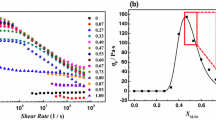Abstract
A better understanding of the interactions between poly(ethylene oxide) (PEO)-based nonionic surfactants and smectite is important to fully comprehend the transport and the fate of nonionic surfactants in the environment and to design novel organo-clay composites. We studied the bonding between the surfactants and smectite and the molecular conformations of the surfactants in the interlayer of smectite. A reference polymer PEG and three nonionic surfactants—Brij 56, Brij 700, and PE-PEG—were intercalated into a smectite. The polymers and the composites were characterized with X-ray diffraction (XRD) and Fourier transform infrared (FT-IR) spectroscopy. The XRD and FT-IR results indicate that the bulk surfactants existed as crystalline materials at room temperature, and surfactant molecules had both helical/extended diblock and planar zigzag conformations. The surfactants intercalated smectite and expanded the d(001) spacing of smectite to nearly 1.8 nm. The shapes and positions of the IR bands of interlayer surfactants were similar to those of the melted (amorphous) bulk polymers: the wagging vibrations of the CH2 merged to a single band at 1,350 cm−1, the twisting bands of CH2 had 9 cm−1 or more blue shifts. These changes imply that the PEO segments of the surfactants existed with a distorted and extended conformation in the interlayer of smectite, and this extended conformation was an intermediate form of the helical and planar zigzag conformations. The molecular conformation of the interlayer surfactant was not affected by the seven types of exchangeable cations (Na+, K+, Ca2+, Mg2+, Cu2+, Ni2+, and H+) tested. There were 20 cm−1 or more red shifts from the C–O–C stretching bands when the surfactants were adsorbed. The red shifts suggest that surfactants were bonded to smectite mainly through (1) H-bonding between oxygen atoms of the PEO segments and water molecules in hydration shells of the exchangeable cations, and (2) direct coordination or ion–dipole interaction between the oxygen atoms of the PEO segments and the exchangeable cations. With the extended conformation, the oxygen atoms of the PEO segments have maximum exposure to the bonding water molecules and exchangeable cations.








Similar content being viewed by others
References
Breen C, Thompson G, Webb M (1999) J Mater Chem 9:3159
Deng Y, Dixon JB, White GN (2003) Clays Clay Miner 51:150
Desbene PL, Portet F, Treiner C (1997) J Colloid Interface Sci 190:350
Portet F, Desbene PL, Treiner C (1997) J Colloid Interface Sci 194:379
Portet F, Desbene PL, Treiner C (1998) J Colloid Interface Sci 208:415
Nevskaia DM, Guerrero-Ruiz A, López-González JdD (1996) J Colloid Interface Sci 181:571
Tahani A, Van Damme H, Noik C, Levitz P (1996) J Colloid Interface Sci 184:469
Pougnet S, Lindheimer M, Partyka S, Cot D, Brun B (1990) Calorim Anal Therm 20-21:147
Theng BKG (1974) The chemistry of clay-organic reactions. John Wiley and Sons, New York
Theng BKG (1980) Chem N Z 44:194
Theng BKG (1982) Clays Clay Miner 30:1
Deng Youjun, Dixon Joe B (2002) Soil organic matter and organic-mineral interactions. In: Dixon Joe B, Schulze Darrell G (eds) Soil mineralogy with environmental applications vol 7 of Soil Science Society of America Book Series. Soil Science Society of America Inc, Madison, Wisconsin, USA, pp 69–107
Matsuura H(1990) Trends Phys Chem 1:89
Matsuura H, Fukuhara K, Takashima K, Sakakibara M (1991) J Phys Chem 95:10800
Matsuura H, Fukuhara K, Masatoki S, Sakakibara M (1991) J Am Chem Soc 113:1193
Takahashi Y, Tadokoro H (1973) Macromolecules 6:672
Yoshihara T, Tadokoro H, Murahashi S (1964) J Chem Phys 41:2902
Dissanayake MAKL, Frech R (1995) Macromolecules 28:5312
Enriquez EP, Granick S (1996) Colloids Surf A 113:11
Ramana Rao G, Castiglioni C, Gussoni M, Zerbi G, Martuscelli E (1985) Polymer 26:811
Takahashi Y, Sumita I, Tadokoro H (1973) J Polym Sci Polym Phys Ed 11:2113
Tai K, Tadokoro H (1974) Macromolecules 7:507
Aranda P, Ruiz-Hitzky E (1992) Chem Mater 4:1395
Ruiz-Hitzky E, Aranda P (2000) Electroactive polymers intercalated in clays and related solids. In: Pinnavaia TJ, Beall G (eds) Polymer-clay nanocomposites. John Wiley and Sons Ltd, Chichester, pp 19–46
Bujdak J, Hackett E, Giannelis EP (2000) Chem Mater 12: 2168
Hackett E, Manias E, Giannelis EP (2000) Chem Mater 12:2161
Nelson DW, Sommers LE (1996) Total carbon organic carbon and organic matter. In: Sparks DL (eds) Methods of soil analysis: chemical methods Part 3. Soil Science Society of America Inc., Madison, Wisconsin, USA, pp 961–1010
White JL, Roth CB (1986) Infrared Spectrometry. In: Klute A (eds) Methods of Soil Analysis: Part 1 Physical and Mineralogical Methods (2nd ed). Soil Science Society of America Inc., Madison, Wisconsin, USA, pp 291–330
Marcos JI, Orlandi E, Zerbi G (1990) Polymer 31:1899
Kimura N, Umemura J, Hayashi S (1996) J Colloid Interface Sci 182:356
Yan L, Roth CB, Low PF (1996) J Colloid Interface Sci 184:663
Yan L, Roth CB, Low PF (1996) Langmuir 12:4421
Aranda P, Ruiz-Hitzky E (1994) Acta Polym 45: 59
Aranda P, Ruiz-Hitzky E (1999) Appl Clay Sci 15:119
Susko FJ (1990) Miner Metall Process 7:206
Susko FJ (1991) Trans Soc Min Metall, Explor 288:206
Parfitt RL, Greenland DJ (1970) Clay Miner 8:305
Parfitt RL, Greenland DJ (1970) Clay Miner 8:317
Acknowledgements
The first author thanks Tom Slick Fellowship, Texas A&M University, for offering a one-year fellowship during this project. Fugen Dou performed surfactant loading quantification. Dr Richard Dress helped with optical microscopic examination of the polymers. We thank an anonymous reviewer for constructive suggestions on improving the manuscript.
Author information
Authors and Affiliations
Corresponding author
Rights and permissions
About this article
Cite this article
Deng, Y., Dixon, J.B. & White, G.N. Bonding mechanisms and conformation of poly(ethylene oxide)-based surfactants in interlayer of smectite. Colloid Polym Sci 284, 347–356 (2006). https://doi.org/10.1007/s00396-005-1388-0
Received:
Accepted:
Published:
Issue Date:
DOI: https://doi.org/10.1007/s00396-005-1388-0




